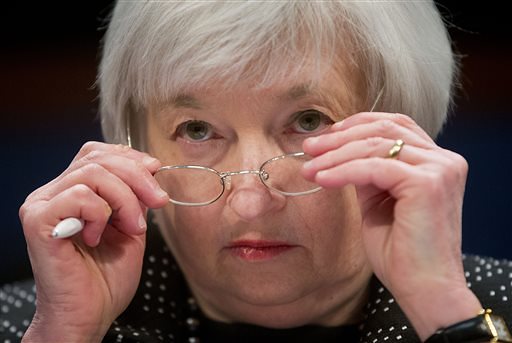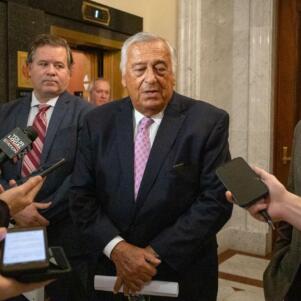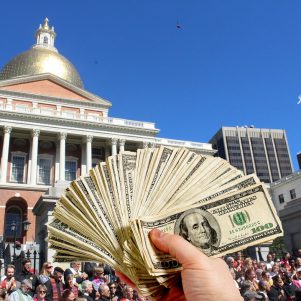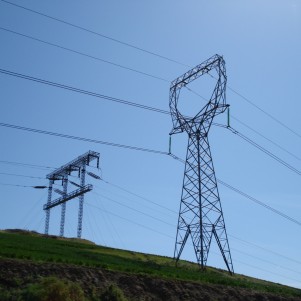Fed rate hike likely to push up consumer credit costs
By Associated Press | December 16, 2015, 16:16 EST
 Federal Reserve Chair Janet Yellen testifies about Fed policy before lawmakers on Capitol Hill. (AP file photo/Pablo Martinez Monsivais)
Federal Reserve Chair Janet Yellen testifies about Fed policy before lawmakers on Capitol Hill. (AP file photo/Pablo Martinez Monsivais) WASHINGTON (AP) — The Federal Reserve’s interest rate “liftoff” Wednesday probably will nudge consumer credit costs higher, making carrying a balance on a home equity loan or credit card more expensive. But it isn’t likely to push up long-term mortgage rates or even the cost of car loans right away, as the increase has little immediate influence on those forms of lending.
By raising the Fed funds rate by one-quarter of a percentage point, to 0.5 percent, policy makers finally ended months of speculation about whether and when they would start raising the overnight lending rate used by banks when they make loans of less than a day’s duration to other banks. It has hovered near zero since the last recession as the central bank sought to foster economic expansion. The move Wednesday is the first step in returning the rate to a more normal level.
“The interest rate impact on the typical household from a quarter percentage point move is almost inconsequential,” said Greg McBride, chief financial analyst at Bankrate.com. “Most people won’t even notice.”
The increase in short-term borrowing costs for banks is intended to prod banks to boost certain other credit rates, but not by much. And combined with market forces, including global investment risk levels, U.S. interest rates overall are expected to remain unusually low. But the Fed funds rate has hovered near zero for over six years, cutting long-term borrowing costs to historic lows, producing significant savings for consumers, corporations and government borrowers. Economists say that won’t change quickly.
The rate the Fed controls is only one factor among many that can influence longer-term borrowing costs. And the Fed made clear it will assess the economy’s health before raising rates further.
Mortgage rates tend to move in sync with the yield on 10-year Treasury notes. When inflation remains as low as it is now, Treasury notes, with their modest returns, are considered a safe and decent investment. And heavy purchases of Treasurys by U.S. and foreign investors — and by many foreign governments, such as China — help keep those yields low.
“The demand for Treasurys has mushroomed,” said Carl Tannenbaum, chief economist at Northern Trust. “What that means is that for any given monetary policy, interest rates are still going to be lower than they would have been 10 or 15 years ago.”
The Fed’s decision to raise rates is in many ways a healthy sign: It’s a vote of confidence that the economy, 6½ years after the Great Recession officially ended, can finally withstand higher borrowing costs and keep growing at an acceptable pace.
Even with a rate increase, most economists expect consumer spending to stay healthy and solid hiring to continue, perhaps even driving unemployment even further below its current low level of 5 percent. Should the economy stumble, the Fed could postpone further rate increases.
Other trends are also working in consumers’ favor: Gas prices are still falling, and there are signs that paychecks are finally starting to rise after years of sluggish growth.
“These things are good for the consumer and will easily outweigh the impact of a rate increase,” said Chris Christopher, an economist at forecasting firm IHS Global Insight.
The most visible effects of the Fed increases will probably be in short-term borrowing. Rates for credit cards and home equity lines of credit should rise, typically by the same amount as the Fed’s increase. The increases could appear as soon as one or two months after the Fed’s action. Those rates are tied to banks’ prime rate, which responds quickly to the Fed’s changes.
Also, Americans with adjustable-rate mortgages will probably face a higher rate at the date of their next adjustment. Auto-loan costs may rise as well, economists said, though not as fast as the short-term rate the Fed controls. Auto-loan rates typically follow the yield on two-year Treasurys.
Bankrate’s McBride calculates that for a $25,000, five-year car loan, a one-quarter percentage point increase would boost monthly payments by precisely $3.
Besides, most people buy homes for reasons that have little to do with a slight rise or fall in mortgage rates, McBride said. They tend to buy when they feel financially secure or experience a major life change, such as having children.
“All those reasons people buy houses remain the same, whether mortgage rates are 4 percent or 4.25 percent,” McBride said.
Last month, Doug Lewandowski moved up the closing date on a two-bedroom Chicago condo he is buying to ensure that he could lock in his rate. He has seen mortgage rates rise by a quarter-point since he started looking in August. Still, the timing of the Fed’s move wasn’t a big factor in his decision.
“I didn’t want rates to jump up significantly, but I wasn’t willing to settle on a place just to get a lower interest rate,” he said.
Lewandowski’s outlook, if typical of prospective homeowners, is one reason many economists think home sales may rise next year even if mortgage rates tick up.
Many analysts expect the Fed to gradually raise its short-term rate by a total of 1 percentage point by the end of 2016. If so, Frank Nothaft, chief economist at CoreLogic, forecasts that the average 30-year fixed mortgage would rise from roughly 4 percent to about 4.5 percent.
To put that in perspective, before the Great Recession the 30-year fixed mortgage rate never fell below even 5 percent.
Written by Christopher S. Rugaber











